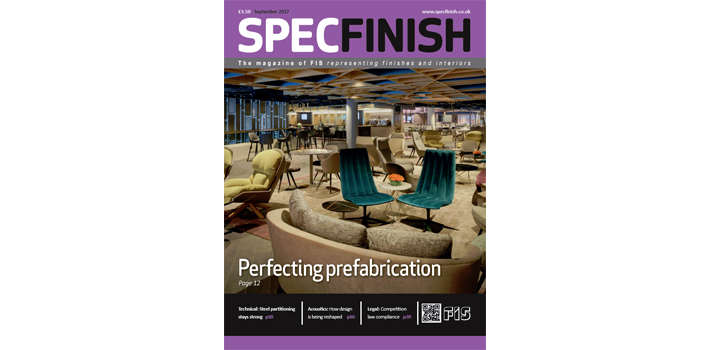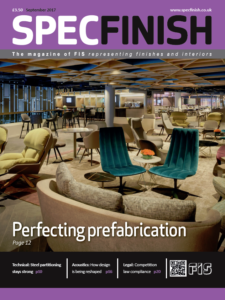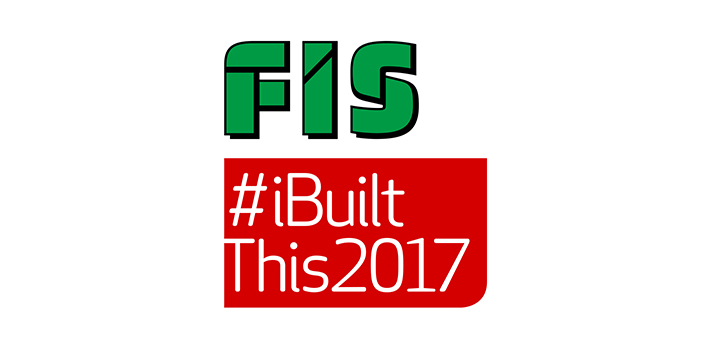
by Nicky Smith | 31 Aug, 2017 | Main News Feed
 In the September edition of SpecFinish, Paul Thompson looks at the industry’s shift towards off-site fabrication.
In the September edition of SpecFinish, Paul Thompson looks at the industry’s shift towards off-site fabrication.
The launch of FIS Skills’ #iBuiltThis2017 is featured on page 18. Find out how you can enter the competition to be in with a chance of winning a fabulous prize!
In the technical article, Joe Cilia looks at steel partitioning and why sales are growing.
Read more in the September edition of SpecFinish online here or the PDF version here.

by Nicky Smith | 25 Aug, 2017 | Main News Feed
FIS Skills launches its flagship social media competition ‘I Built This’ today. As an image-led campaign, utilising the Instagram and Twitter platforms, it is designed to attract young people, those who work in the construction industry and the general public. By submitting photographs of something that they have built, using the hashtag #iBuiltThis2017 the aim is to promote the UK built environment in a fun and inspiring way.
The competition will run for a period of three weeks, with submissions being accepted from 4 September. Winners will be announced at UK Construction Week which takes place from 10 to 12 October 2017 at the NEC in Birmingham.
FIS Skills Delivery Director Helen Yeulet said: “This is a part of FIS Skills’ ongoing vision to drive change and a better understanding of the industry and the opportunities within it. The competition aims to utilise the pride in an individual’s achievements to assist in improving perceptions and image, increase careers awareness and engagement nationally.”
Chief executive David Frise added: “The only way to close the skills gap and improve industry perceptions is through strong collaboration and working together. This campaign provides the partnerships to join the dots across the industry with educators and potential new entrants and engage with young people in a fun and exciting new way.”
Read the Press Release

by Nicky Smith | 10 Aug, 2017 | Main News Feed
Assembling buildings as a single, integrated system
by David Frise
For a building to be a ‘product’, you have to start the process off correctly by designing it before you start. Not rocket science, but rarely achievable in the “crack on” world of construction. Most projects start on-site far too early and well before the design is fully completed. This means that we end up not in design and build mode, but in the folly of build and design. A harum-scarum process that is desperately inefficient and leads to massive additional costs. The Get it Right Initiative estimates anywhere between 10-24% of cost stems from avoidable error, more than the total profits of all the construction industry put together. It is no wonder construction is high risk and low margin and why so many Chief Executives of major contractors have short term periods in charge.
It often appears that the building is a secondary requirement. We all invest in property, either personally or through our pensions. An investment vehicle requires less focus on specification and more on the need to be on time and on budget, to generate that return on investment. Of course, the best clients recognise that this does not pay in the long term, but there are many that do not.
This drives inefficient behaviours down the supply chain because, if you are not concerned about the quality of the product, you will not need to be concerned about the people who install it. This leads to you also not needing to worry about paying them on time. So poor payment practices are rife as a result.
The current system needs on-site activity to trigger payments down the supply chain, so we all want to see deliveries of materials and site progress to improve our cash flow. The result is cluttered sites and out of sequence works to make progress look better than it is (nothing makes a room look near to completion like a ceiling, even if the services above it are yet to be installed). This also leads to late design changes, reworking and yet more increased defects.
Build and design delivers broken buildings, while the process of delivering them causes broken people. The most likely way you will die in construction is suicide. The pressures of working in the industry, especially as a specialist contractor, are enormous as you chase slim margins and impossible programmes and if your house is on the line, this often becomes unbearable.
It doesn’t have to be this way
Planning departments could give planning consent but not allow a start on site until the design had been completed or perhaps a Regulation 38 Fire Plan signed off by Building Control. This would prevent the immediate start of build and design. The freeholder would pay a professional to sign off the design so there would be no additional workload on planning departments.
Of course, if the developer used BIM this process would be easier to complete. You would also encourage the use of DFMA and off-site techniques that would improve efficiency and improve safety, as fewer workers would be required on site. The same could be said for reductions in waste.
Imagine a world where buildings were assembled quickly on-site, causing less disruption to local residents and businesses and at a lower cost; buildings that not only looked like the planning application but performed to the correct standards and were defect free. This would surely be a more profitable industry that attracts the brightest and the best. We might even address our “image” problem.
We would like to acknowledge Building Engineering Services Association (BESA) in allowing FIS to reproduce David Frise’s article.

by Nicky Smith | 10 Aug, 2017 | Main News Feed
The Symptoms Vs the Disease
by David Frise
Let’s look at the issues caused by regulations and lack of enforcement:-
There are rightly calls for wholesale change and after years of sniping at ‘unnecessary regulations’, we may have to reverse the attempts at cutting red tape.
But what were those regulations that were consigned to history, might they have led to this tragedy? That is a more difficult question to answer. We all complain about red tape but when asked which regulations would you like to get rid of, invariably a room full of construction specialists will be unable to name one. In fact, they will usually include some they feel should be added.
So it is not necessarily that the government has revoked some essential piece of safety regulation, it is more that they have set the tone. Regulation is an unnecessary impediment to innovation and progress, usually dreamed up by some faceless bureaucrat that the government can do nothing about, but accept and implement.
As a consequence, you have a culture of non-enforcement. The biggest complaint of specialist contractors is that building regulations are paid lip service. There are precious few prosecutions for a failure meet the requirements of building standards and none for a failure to comply with the energy efficiency targets described in Part L of building regulations. When challenged, DCLG, the department responsible for building regulations, ask “what should we do, call in the building police?”
At the very least there is a culture of neglect, as we have seen with the delays to Part B of building regulations, which include fire regulations. In fact, the role of Building Control has progressively been downgraded, with the provision of private providers, this adds a commercial dimension to the checking of buildings. It is not about doing a thorough inspection, it’s ‘can you do it cheaply’ and ‘can you help get around more expensive requirements by beneficially interpreting regulations?’
The process was clearly identified in the recently published Edinburgh Schools Report into the closure of 17 schools in Edinburgh following a wall collapse;
A number of witnesses to the Inquiry identified a desire to reduce the cost of fees as a major factor in deciding the level of provision of effective inspection of construction, rather than a serious assessment of the risks of not providing for adequate independent scrutiny
Consequently, with little or no chance of prosecution, a culture of non-compliance is prevalent. And this is portrayed, or it was until Grenfell, as a victimless crime.
This culture of neglect will hopefully be addressed and redressed with Dame Judith Hackitt, Chair of the Engineering Employers Federation, leading a new independent review of Building Regulations. The review announced on Friday as part of the continuing response to the Grenfell tragedy and is the first opportunity for meaningful review of Building Regulations in many years. At the BESA, we are encouraged by the broader focus of this review and its focus on tall buildings, compliance and enforcement.
The simple solution to addressing regulation and enforcement does not require rafts of legislation (except perhaps in fire safety), but the simple enforcement of simplified regulations, which are designed to give us a safe, healthy built environment that we can enjoy in a sustainable way. For this to work, Building Regulations and Planning Consents need to be matched to output, not theoretical models as they currently are. In other words, the process should be about what you actually deliver, not what you promised to deliver.
We are encouraged by the broader focus of this review and its focus on tall buildings, compliance and enforcement. Dame Judith’s appointment is significant, as a former head of the Health and Safety Executive and an active fellow of the Royal Academy of Engineering, it shows the government appreciates the importance of engineering expertise to undertake a review of this nature.
For Part L of Building Regulations, which deals with the conservation of fuel and power, for example, this would mean instead of complicated SAP and SBEM modelling, the requirement would be to meet a notional energy and carbon target per square meter. How you achieve that would be up to you as the expert designer, but you would be required to prove that you had met the target or produce an explanation of why you had not.
Someone with an engineering background, like Dame Judith, will understand what changes can be made for the future and how to make the regulations more effective.
Who will enforce it? Not the DCLG’s “buildings police”, but the freeholder of the property. They would be required to prove that the building meets the requirements of building and planning regulations and the local authority could audit a small percentage. The same principle that HMRC employs, with crippling fines for those who try to cheat the system.
We may see a future where freeholders would need to employ professional experts to carry out this task on their behalf and at their own expense. You would also have to allow scope for those who genuinely innovate and fail (not with safety of course) but otherwise you place the emphasis and responsibility where it should lie; with the freeholder.
Extra Cost?
Before we throw our hands up in horror at the additional expense, they are not being asked to do anything they are not already required to – but don’t. Surely, they intend to build the thing they put in for planning? You wouldn’t dream of getting in an aircraft that had not been tested, so why would you live or work in an untested building, when you spend over 80% of your time inside?
Our built environment has a huge impact on our society, the buildings and places we construct will be there for years. A couple of thousand pounds saved by a developer or a contractor in the short term can have huge costs long term for all of us when it comes to health, safety and economics. With 455 towers planned for London alone, the focus will be on these buildings but the same issues apply to our schools (witness the recent Edinburgh Schools’ closures because of structural safety concerns) our hospitals, offices and homes.
We have seen countless reports on the ills of the construction industry, going all the way back to the Simon Report in 1944. Almost all focus on dealing with the symptoms and not the disease. Talk of collaboration, a digital revolution and innovation will all help, but to fix this we need to start with the disease. We need to be building an entire product, not just assembling a collection of individual products. The freeholder has to want a complete product that meets design, complies with regulations and planning requirements and must have responsibility to deliver that to the population at large.
We all live in the built environment, so is it unreasonable to ask freeholders to be responsible for making sure they enhance that environment through sustainable, safe development?
The responsibility to ensure the compliance of the building with the required standards lies with the builder who should have in place proper inspection of the works, however by definition such self-managed inspections cannot be independent of the builder.
With the launch of Dame Judith’s new independent review, we are finally going to have an open and frank discussion on the regulatory system around design, construction and ongoing management of buildings. We can examine the related compliance and enforcement issues and we are ready to work together towards updated building regulations that are safer, more efficient and fit for purpose.
We would like to acknowledge Building Engineering Services Association (BESA) in allowing FIS to reproduce David Frise’s article.

by Nicky Smith | 8 Aug, 2017 | Main News Feed
FIS, in association with McClelland Media Ltd, launched a Leaderboard for the Top 500 active Twitter users in the fit-out sector on 7 August. The aim of the new Leaderboard is to raise social media engagement for our members and promote the finishes and interiors sector to the wider industry.
How does the Leaderboard work?
Companies and individuals who have an interest in the fit-out Sector, including Finishes and Interior Systems such as ceilings, drylining, heritage plastering, operable walls, partitions, plastering and raised-access flooring, have been nominated to Jim McClelland who curates and manages the Leaderboard. The ranking order is determined by Klout Score. Each Monday morning, the Leaderboard updates to provide the new ranking; if you choose to follow the Leaderboard, you will be notified each Monday via email of your rank and Klout Score. Jim McClelland tweets from @SustMemeTop500, providing additional exposure for our Leaderboard, such as tweeting the Top 20, new entrants and top climbers.
How can my company or an individual feature on the Leaderboard?
For potential inclusion, simply Tweet the company or individual’s Twitter Username to @SustMemeTop500, using the hashtag #Top500ADDFitOut. Your Klout Score will determine if, and in which position, you enter the Leaderboard. To aid your Klout, get posting, talking and influencing on your social media channels. FIS looks forward to the Fit-Out Top 500 helping to raise the profile of our members to the wider industry.
If you have any questions about the Leaderboard, please contact nickysmith@thefis.org



 In the September edition of SpecFinish, Paul Thompson looks at the industry’s shift towards off-site fabrication.
In the September edition of SpecFinish, Paul Thompson looks at the industry’s shift towards off-site fabrication.


